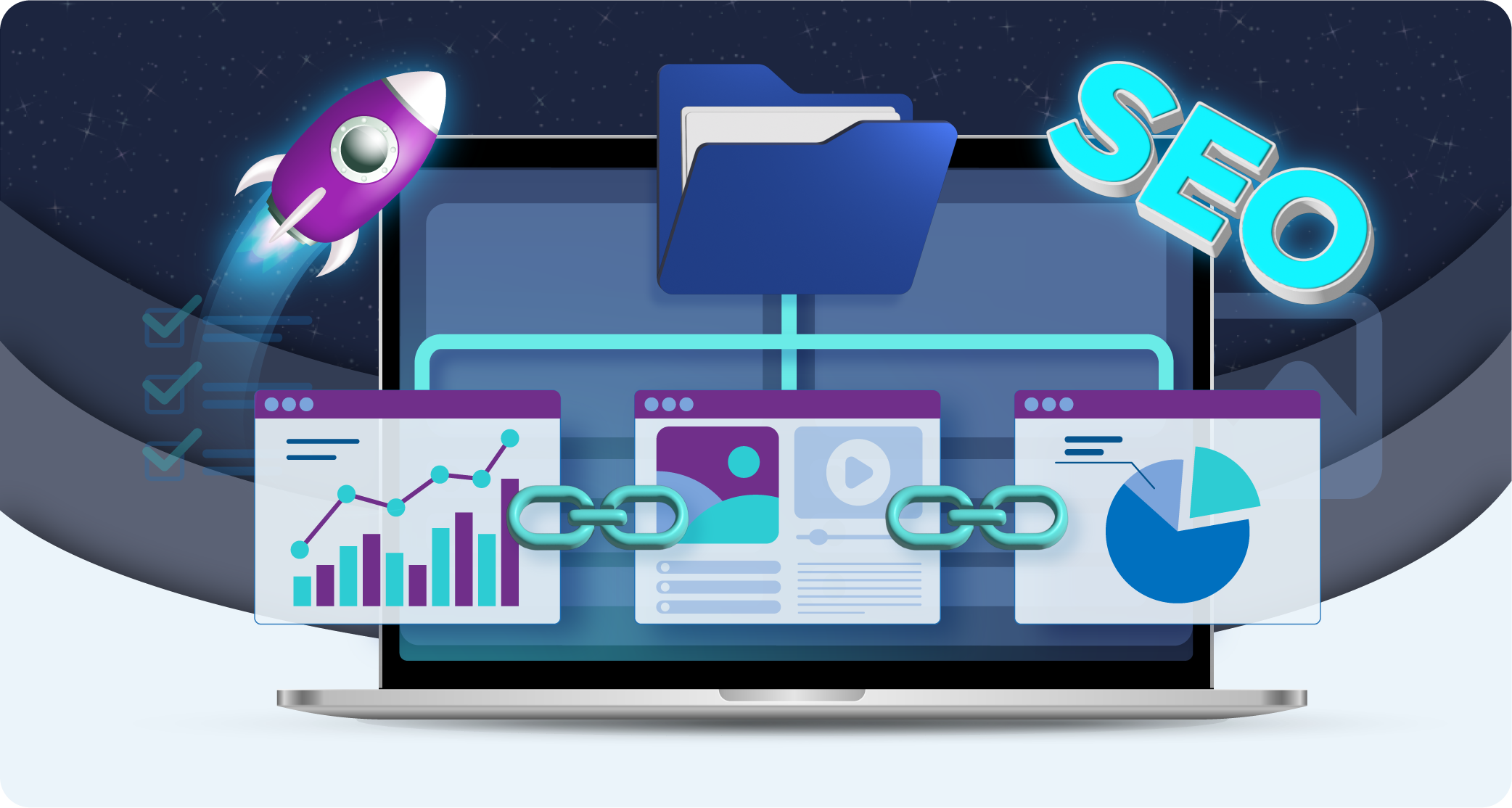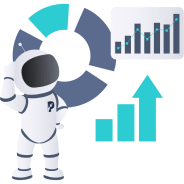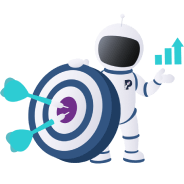

Enhancing SEO With Internal Linking: 5 Best Practices for Better Rankings
Key takeaways
-
Internal links guide both users and search engines, improving website navigation and SEO performance.
-
A successful internal linking structure prioritises high-value pages and uses descriptive, keyword-rich anchor text.
-
Regular audits and updates ensure your internal links remain effective as your site evolves.
One often overlooked yet incredibly impactful element of SEO is internal linking. This is a simple but powerful way to improve your website’s visibility in the search engine results pages.
At its core, internal linking connects the pages on your site, creating a navigational roadmap for both your visitors and search engines. You’re guiding users through your website and helping search engines understand each page. Done considerately, internal linking can boost your rankings, enhance your site’s usability, and increase conversions.
In this blog, we’ll explore why internal links should be part of your SEO strategy and provide five best practices for using them.
Let’s dive in.
What are internal links?
Unlike external links, which lead users to different websites, internal links help users and search engines navigate your site.
Internal links lead to different content within the same website domain. They will usually take users to a different webpage, but they can also lead them to a different spot lower down the same page.
Internal linking provides users with more content that is relevant and interesting to them. Hopefully, your use of internal links will keep visitors on your website for longer.
But they also serve an SEO purpose; internal links are part of a website’s architecture. They are read by search engine bots and spread ‘ranking power’ throughout the website.
Why should you use internal links?
- Internal links are fundamental to search engine bots discovering and indexing your website, making them crucial to boosting SEO performance. A logical linking structure will signal to search engines the most important pages.
- Strategic internal linking encourages users to spend more time on your site. So, you can expect to see increased engagement and retention rates from this practice.
- Internal links pass link equity (also known as “link juice”) between pages. This means that well-linked pages can transfer some of their SEO authority to other, less visible pages, helping improve their search rankings.
- Internal links create a smoother user experience by helping visitors easily find relevant content. For an e-commerce business, this could mean linking product pages to related items, increasing the likelihood of additional purchases. SaaS companies might use internal links to guide users from a feature overview to a pricing page or blog post explaining the value of a specific tool.
- Internal links can guide visitors toward specific actions, such as making a purchase, signing up for a trial, or subscribing to a newsletter. E-commerce sites often implement internal links like “You May Also Like” which can boost cross-selling and upselling opportunities.
Whatever incentives appeal to you about internal linking, there are certainly several to look forward to. Before you begin your new strategy, there are a few things to bear in mind.
5 best practices for internal linking
Before jumping the gun, you should be aware of the best internal linking practices. You might have some misconceptions that could harm your strategy if you’re not fully prepared. For example, some believe that you can just add internal links anywhere without a strategy or that all pages should have the same number of internal links in the name of ‘fairness’. These are incorrect.
Here’s what you need to know:
1. Create a hierarchical website structure
Right from the get-go, you can ensure your website will be easy to navigate for both users and search engine bots. A hierarchically organised site structure simply makes sense.
For example, a pyramid structure complements a user’s journey from discovering your website or content and then looking for further details. (This is when the homepage links to main category pages, which then link to subcategories and individual content pages.) From those individual content pages, you could lead users to pages that reveal more specialised details about that topic.
It’s best practice to limit the number of times users will have to click to discover an important page. Some suggest keeping pages no further than 3-4 clicks away from the homepage. To stop users from getting lost, you can use breadcrumb navigation. This will help them retrace their steps if they need to.
Users will also expect to be able to navigate via your main menu or footer. Make sure these sections have links to important pages such as blog or product categories and customer service.
2. Prioritise high-value pages
What are your high-priority pages? These are usually product pages, pricing pages, case studies, or blog pages that discuss important topics with high-converting keywords.
It’s key that you can guide users to these conversion-focused pages. Internal linking can help with this by creating links to them from high-traffic web pages such as your homepage.
Internal links pointing to these pages will signal their importance to search engine bots, suggesting to them that they should be ranked more highly.
When linking from the body of content, make sure it’s done naturally. Links should make sense contextually and only direct users to related pages. For example, create a link from a blog post about ‘Best Project Management Tools’ to your own tool’s product page.
While prioritising high-value pages, you also want to make sure none of your pages are orphaned (i.e., when no pages internally link to them). You can use tools like Yoast to analyse how internal links are distributed across your website.
3. Keep anchor text descriptive and keyword-rich
Anchor text is extremely important. It will be read by both site visitors and search engine bots, so it must make sense and be relevant.
One approach is to use anchor text that resembles the URL of the webpage it’s linking to; this makes the most ‘sense’ to bots. Anchor text like ‘discover the top ten project management tools’ for a URL like ‘www.website.com/top-ten-project-management-tools’ is clearly more descriptive than something like ‘best tools’.
If you’re linking to a page that breaks down your service’s pricing plans, the anchor text ‘Learn more about our pricing models’ is better than ‘Learn more’ because it indicates exactly what users can expect to be led to.
This approach is better than stuffing in keywords unnaturally – anchor text must be readable and flow with the rest of the content it resides in. Additionally, some suggest diversifying anchor text so that it’s not the same throughout your whole website.
When in doubt, you can use a tool like Google Search Console to identify any anchor text that is overused or poor-quality.
Follow this internal link to learn more about anchor text link paths (…see what we did there?)
4. Links should be efficient for bots to crawl
When search engine bots crawl and index web pages, internal links are crucial in leading them to new pages that they haven’t indexed before. That’s why it’s so important to remember orphaned pages, as they’re likely to be entirely missed by bots if you don’t provide internal links to them.
Bots will prioritise crawling pages based on their authority and link depth (how many clicks the page is from the homepage), reemphasising what we mentioned earlier about keeping to 3-4 clicks. Bots also prefer HTML over JavaScript, so bear this in mind when coding your internal links and navigation.
Plus, bots are limited by their crawl budget, making it vital for larger websites to indicate important pages with internal links. You can also protect the crawl budget by not linking to ‘noindex’ pages and checking that your robots.txt file isn’t blocking important pages.
To help bots along, you might want to create an XML sitemap to upload to Google Search Console.
5. Maintain your internal links
Over time, your internal links may break or become outdated which can harm both SEO performance and user experience. Tools like Screaming Frog can quickly scan your website for broken links if you ever want to check them.
Outdated links should be replaced as soon as possible; for instance, if you publish a new blog and its content is more up-to-date or relevant to users. In fact, whenever you publish new content to your website you should promptly integrate it into your site’s structure with relevant internal links.

Final thoughts
Internal linking might seem simple, but its impact on your website’s SEO and user experience is profound. Remember, it’s not just about adding links – it’s about adding the right links, in the right places.
As you implement this strategy, take the time to regularly review and optimise your internal links. The effort you invest now will pay off in the form of better rankings, more engaged users, and ultimately, more conversions.
If you want some help with your internal linking, reach out to us here at purpleplanet.











